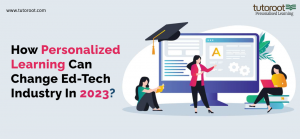How Personalised Learning Change EdTech Industry in 2025?

Chromebooks have replaced textbooks, blackboards have been replaced with Smartboards, and notes have been changed into video lectures. Technology has made information available at the touch of a fingertip. All of this is now feasible because of the numerous online learning platforms and tailored learning models available today.
There are several personalised learning systems available for instructors and students, but the difficulty is determining which one is the best. Some learning platforms are superior to others, therefore we’re here to dispel your fears and introduce you to the greatest platforms for a customized learning environment.
What is Personalised Learning?
Personalised learning is an effective and creative method of learning that aims to tailor learning to each student’s unique strengths, needs, abilities, and interests. This helps in providing the learner with the most appropriate learning plan.
What is the EdTech Industry?
Edtech, or education technology, is the blend of information technology tools and educational methods designed to facilitate and improve learning.
Technology in the education sector is here to stay. The rise of ed-tech tools is changing learning in several ways. For example, edtech robots, personalised learning, virtual reality classes, and gamified classroom activities help students stay involved by providing exciting ways to learn. And ed-tech IoT devices are being praised for their capacity to build digital classrooms for children regardless of whether they are in school, on the bus, or at home. Even machine learning and blockchain tools help teachers assess tests and hold students accountable for assignments.
Best EdTech Industry Trends for 2025
Virtual Reality and Augmented Reality
Virtual Reality and Augmented Reality technologies provide a safe environment for youngsters to study complicated ideas and receive hands-on experience in low-risk virtual situations. STEM-related courses, medical simulations, arts and humanities resources, and technical education may all be improved by AR and VR.
Another reason is that Virtual Reality and Augmented Reality technologies are on their way to becoming one of the most promising additions to the ‘Edtech’ area since they can convey knowledge in new and engaging ways.
Nano Learning
The nano-learning approach, often known as bite-sized learning, divides complicated concepts into smaller, more consumable bits. It is a highly focused learning strategy in which students are given subject matter in little doses over a short period.
This is a continuous learning process in which learning sessions are two to ten-minute multimedia-rich lessons that aim to give large amounts of knowledge in the smallest amount of time feasible to guarantee a student understands and learns it rapidly.
Artificial Intelligence
AI, or Artificial Intelligence, can interact with humans and assist them in becoming the next disruptive thing in the technology world, capable of transforming and revolutionizing various sectors, including education, as well as addressing some of the most pressing challenges in education today, by innovating teaching and learning practices.
Nonetheless, it is critical to remember that AI should be human-centred. A combination of teachers and AI will greatly benefit students by offering sustainable and high-quality education by bringing a clear picture with different variations.
How Personalised Learning Differ from Other Trends?
The basic idea behind introducing personalised learning is that each child learns in a different way and at a different pace. Each student receives a “learning plan” based on how they learn, what they know, and what their talents and interests are.
There are various types of personalised e-learning, and each model has its unique set of features.
Nonetheless, certain features are shared across all systems. Let’s have a look at some of them:
Student-Centered Learning
Students pick their learning style in the classroom via customized learning. Students choose the learning approach that best meets their needs and interests. Students have specific learning objectives, goals, and assignments that they strive to achieve.
The Learning pace of the students
Students can choose their own pace thanks to the flexibility of individualized education. Students can go to new modules only if they have fully grasped the present concept. Students can split their time based on the difficulty of the topics.
Knowledge-Based Approach
Personalised learning relies on conceptual comprehension rather than exam scores. Instructors are more concerned with what and how pupils are learning. Instead of simply preparing students for tests and outcomes, teachers provide an opportunity for them to build relevant real-life skills.
Learn from anywhere and at any time
Learning and teaching applications are available to students and teachers both inside and outside of classrooms and schools. Educational apps are now available to everyone on the planet thanks to cloud technology for education.
Final Notes
Traditional learning methods can be a drag, but personalised learning points can help you transform them into creative methods. Personalised learning builds an innovative platform for students to learn in an engaging environment. It helps every student to reach their maximum potential and plays an important role in bridging the gap. If you would like to choose such an engaging environment for your children, then here is Tutoroot. Join today and let your child reach their learning potential.
